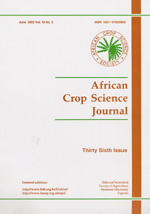
|
African Crop Science Journal
African Crop Science Society
ISSN: 1021-9730
EISSN: 1021-9730
Vol. 6, No. 4, 1998, pp. 329-344
|
 Bioline Code: cs98035
Bioline Code: cs98035
Full paper language: English
Document type: Research Article
Document available free of charge
|
|
|
African Crop Science Journal, Vol. 6, No. 4, 1998, pp. 329-344
| fr |
Mugo, S.N.; Smith, M.E.; Bänziger, M.; Setter, T.L.; Edmeades, G.O. & Elings, A.
Résumé
Deux cultivars de maïs ouverts et
fécondés largement employés dans les
régions centrales et australes de l'Afrique, composés Katumani et
Kito, ont été développés et
améliorés pour la maturité précoce; le
grain de production et l'évasion à la
sécheresse ont été évalués pour
la tolérance à la sécheresse aux niveaux de
semis et de la floraison, et comparés à d'autres populations de
maïs tolérantes à la sécheresse. Pendant
les semis, les cultures à maturité précoce ont
été les plus tolérantes avec une large
accumulation de la biomasse dans les milieux stressés et non
stressés. Cependant, le poids de racines et le rapport
racine/tige était relativement petit. Pendant la
sécheresse, à la floraison, les cultures avaient
fleuri bien avant et ont atteint l'anthèse à 66 jours pour
le Katumani et 73 jours pour le Kito, comparés à une
moyenne de 100 jours par essai. Les grains de production ont
été de 359Kg ha-1 pour le Katumani et de 679Kg ha-1
pour le Kito tandis que la moyenne d'essai était de 1002Kg ha-1 sous
une sévère contrainte. Dans des conditions de bonne
irrigation, les rendements étaient de 3.295Kg ha-1 pour le
Katumani, 4.651Kg ha-1 pour le Kito, par rapport à la
moyenne d'essai de
5.737Kg ha-1. La faible production du grain était
associée à une large intervalle d'ASI de 28 jours pour le Katumani par
rapport à une moyenne de 18 jours pour l'essai; et a de grandes et longues
feuilles enroulées avec une concentration d'acide abiscique. Le Katumani et le Kito
étaient moins stables pour la production dans les milieux
humides.
Mots Clés
acide abiscique, intervalle anthèse, siking, tolérance à la sécheresse, racine: rapport de la pousse, stabilité rendement
|
| |
| en |
Performance Of Early Maturing Katumani And Kito Maize Composites Under Drought at the Seedling And Flowering Stages
Mugo, S.N.; Smith, M.E.; Bänziger, M.; Setter, T.L.; Edmeades, G.O. & Elings, A.
Abstract
Two widely-used open pollinated maize (Zea mays L.)
cultivars from East Africa, Katumani and Kito composites, developed
and improved for early maturity, grain yield and drought escape
were evaluated for drought tolerance at seedling and flowering
stages, and compared with other drought tolerant maize populations.
Under seedling-stage, the early maturing cultivars were the most
drought tolerant with large biomass accumulation in both stress and
non-stress environments. However, root weight and the root: shoot
ratio were relatively small. Under drought at flowering, these
cultivars flowered early and reached anthesis in 66 days (d) for
Katumani and 73 d for Kito, compared to an average of 100 d for the
trial. Grain yields were (359 kg ha-1 for Katumani and 679 kg ha-1
for Kito) than the trial average of 1002 kg ha-1 under severe
stress. Under well-watered conditions the yields were 3,295 kg ha-1
for Katumani, 4,651 kg ha-1 for Kito compared to the trial average
of 5,737 kg ha-1. Low grain yield was associated with a large
anthesis-silking interval (ASI) of 28 d in Katumani compared to an
average of 18 d for the trial; and strong leaf rolling and high
leaf abscisic acid concentration. Katumani and Kito were less
stable for yield across water availability environments
Keywords
Abscisic acid, anthesis-silking interval, drought tolerance, root:shoot ratio, yield stability
|
| |
© Copyright 1998 - African Crop Science Society
|
|
